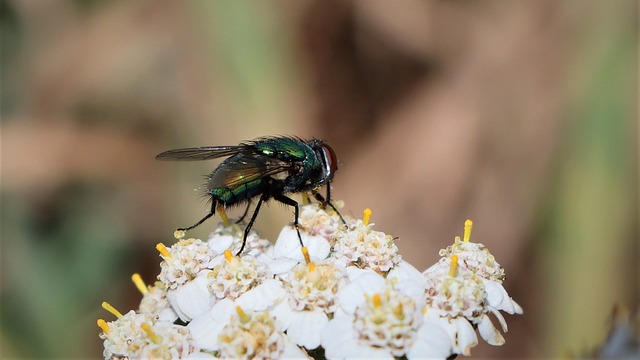In commercial kitchens, effective commercial fly removal is crucial for hygiene and customer safety due to flies acting as disease vectors. Success hinges on understanding fly behavior and implementing a blend of preventive tactics (like eliminating water sources and securing trash) and targeted methods (traps, zappers, natural repellents). An integrated approach creates an inhospitable environment for flies, safeguarding food preparation areas and reducing health risks. Tailored solutions from professional pest control services address unique hotspots like garbage bins, drains, and standing water, utilizing strategies including targeted treatments, exclusion methods, proper waste management, regular cleaning, and the use of insecticides or traps to maintain a sanitary space.
In the bustling world of food service, maintaining a hygienic environment is paramount. Commercial kitchens face unique challenges with commercial fly removal, as these pesky insects can quickly transform from an annoyance to a serious health hazard. This article delves into effective strategies tailored for kitchen environments, focusing on understanding fly behavior and implementing targeted solutions. By identifying hotspots and adopting long-term prevention measures, food establishments can ensure a commercial fly removal success that keeps customers safe and businesses thriving.
Understanding Commercial Fly Removal: The Importance in Kitchens
In commercial kitchens and food preparation areas, implementing effective commercial fly removal strategies is paramount for maintaining hygiene standards and ensuring customer safety. Flies pose a significant risk by serving as vectors for diseases and contaminants, potentially leading to serious health issues and legal consequences. Understanding the behavior and life cycle of flies is crucial in developing tailored removal strategies.
Professionals in the industry must recognize that successful commercial fly removal involves a combination of preventive measures and targeted interventions. This includes eliminating standing water sources, securing trash bins with tight-fitting lids, maintaining clean surfaces, and regular sanitation practices. Additionally, employing specialized equipment like traps and zappers, along with natural repellents, can significantly curb fly populations. Such integrated approaches create an inhospitable environment for flies, minimizing their presence and ensuring a safe, sanitary workspace.
Identifying Hotspots: Common Areas for Fly Attraction and Infestations
Fly infestations in kitchens and food prep areas can be a significant concern for businesses, as they pose both health and safety risks. Identifying hotspots is a crucial step in effective commercial fly removal strategies. These are areas where flies are most attracted and likely to breed, such as garbage bins, drains, and areas with standing water. Food debris left out or improperly stored attracts flies, making kitchen counters, food processing equipment, and nearby surfaces prime locations for their presence.
Understanding these hotspots allows for targeted treatments and preventive measures. Regular cleaning and sanitizing, proper waste management, and sealing entry points can significantly reduce fly populations. Professional pest control services specializing in commercial fly removal can provide tailored solutions, ensuring a hygienic and safe environment for both employees and customers.
Tailored Strategies: Effective Solutions for Kitchen Fly Control
In the bustling kitchen environment, where food is prepared and served, maintaining a pest-free zone is paramount, especially for commercial establishments. Tailored fly removal strategies are essential to combat these persistent insects that can contaminate food sources and pose health risks. Professional pest control services offer effective solutions tailored to each kitchen’s unique needs.
These strategies involve a combination of targeted treatments, exclusion methods, and environmental modifications. Commercial fly removal experts identify the specific types of flies infesting the kitchen, such as houseflies or fruit flies, and implement corresponding control measures. This may include sealing entry points, proper waste management, regular cleaning routines, and the use of targeted insecticides or traps. By adopting these tailored strategies, kitchens can create an inhospitable environment for flies, ensuring food safety and maintaining a sanitary space.
Long-Term Prevention: Maintaining a Fly-Free Food Prep Environment
To achieve long-term prevention and maintain a fly-free food preparation environment in kitchens, a multi-faceted approach is essential. This involves addressing both the internal and external factors that attract flies. For commercial fly removal, regular cleaning and sanitizing routines are paramount. Ensuring all food sources are sealed, garbage bins are securely closed, and any spills or messes are promptly cleaned up significantly reduces fly attraction.
Additionally, fixing any leaks, sealing cracks, and maintaining proper ventilation helps eliminate moisture and potential breeding grounds. Regular inspections and maintenance of exhaust fans and other mechanical systems can further deter flies. Planting herbs like mint, basil, and lemongrass around the kitchen perimeter can also serve as a natural barrier, as their strong scents repel flies without resorting to chemicals.
Implementing tailored fly removal strategies is paramount for maintaining a hygienic and safe kitchen environment. By understanding commercial fly removal techniques, identifying hotspots, and adopting effective solutions, food preparation areas can be transformed from breeding grounds to sanctuaries of sanitation. Long-term prevention through consistent maintenance ensures flies are kept at bay, safeguarding both the quality of food and public health. With these tailored strategies in place, kitchens can thrive as vibrant hubs of culinary creativity without the hassle of pesky fly interruptions.
